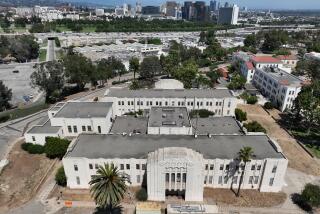SAIGON BY SOUTHWEST
There’s only one corner in Los Angeles where a right turn leads to Native American basket weaving, a left to a camouflage-netted scene reminiscent of “Platoon.” The city signs read Marmion Way and Museum Drive, but nearby, a cluster of handwritten wooden directionals--topped with a human skull--points to the Vietnam battle sites of Chu Lai, Quang Tri and Da Nang.
With its wrought-iron windows and torn MIA flag, canteens and shell casings, this small residential plot has become as much a Mt. Washington landmark as the towering Southwest Museum across the street. Fifty-year-old Ramon Paniagua, who created this front-yard tableau, doesn’t understand the apprehension with which many regard him. He hesitates for a moment before reaching through camouflaged netting to unlock a sliding gate and admit a visitor into his world of war, where lifelike, uniformed mannequins pose amid a handful of jeeps and trucks (he keeps 30 vehicles in storage to rent to Hollywood studios).
Paniagua recalls how, when on a trash treasure hunt at age 8, he unearthed a cigar box with a trove of war medals. As his collection grew, he realized that people devalue war memorabilia. “It gave me something to think about,” he says. “Someone actually fought for this, gave it to his family and then it just gets thrown out.”
Though Paniagua didn’t serve in Vietnam (he found out at his physical that he was partially deaf), three of his closest friends did, and only one came back alive. Among his prized possessions are letters from vets. “These guys know they’re not coming home so they spill their guts out,” he says. He also videotapes veterans and POWs to capture their stories. Based on the recollections of two Vietnam War veterans he interviewed over five years, Paniagua constructed a precise replica of a tiger cage in which prisoners of war were kept.
The city, meanwhile, branded his yard--nicknamed Fort Apache by neighbors--an eyesore, and made him install a fence, which only enhanced the place’s vaguely ominous urban legend. It doesn’t help that Paniagua walks around the neighborhood wearing a Vietnam cavalry hat, which once belonged to a Huey helicopter door gunner.
While such an individualistic exhibition might raise hackles were it located opposite, say, the Getty Center in Brentwood, it seems natural in Mt. Washington, which, true to its Bohemian reputation, seems tolerant. “My first thought was, ‘What’s up with this place?’ ” says neighbor Johanna McCloy. “But when I thought about it, it seemed to be a nice, respectful tribute.”
More to Read
Sign up for The Wild
We’ll help you find the best places to hike, bike and run, as well as the perfect silent spots for meditation and yoga.
You may occasionally receive promotional content from the Los Angeles Times.






